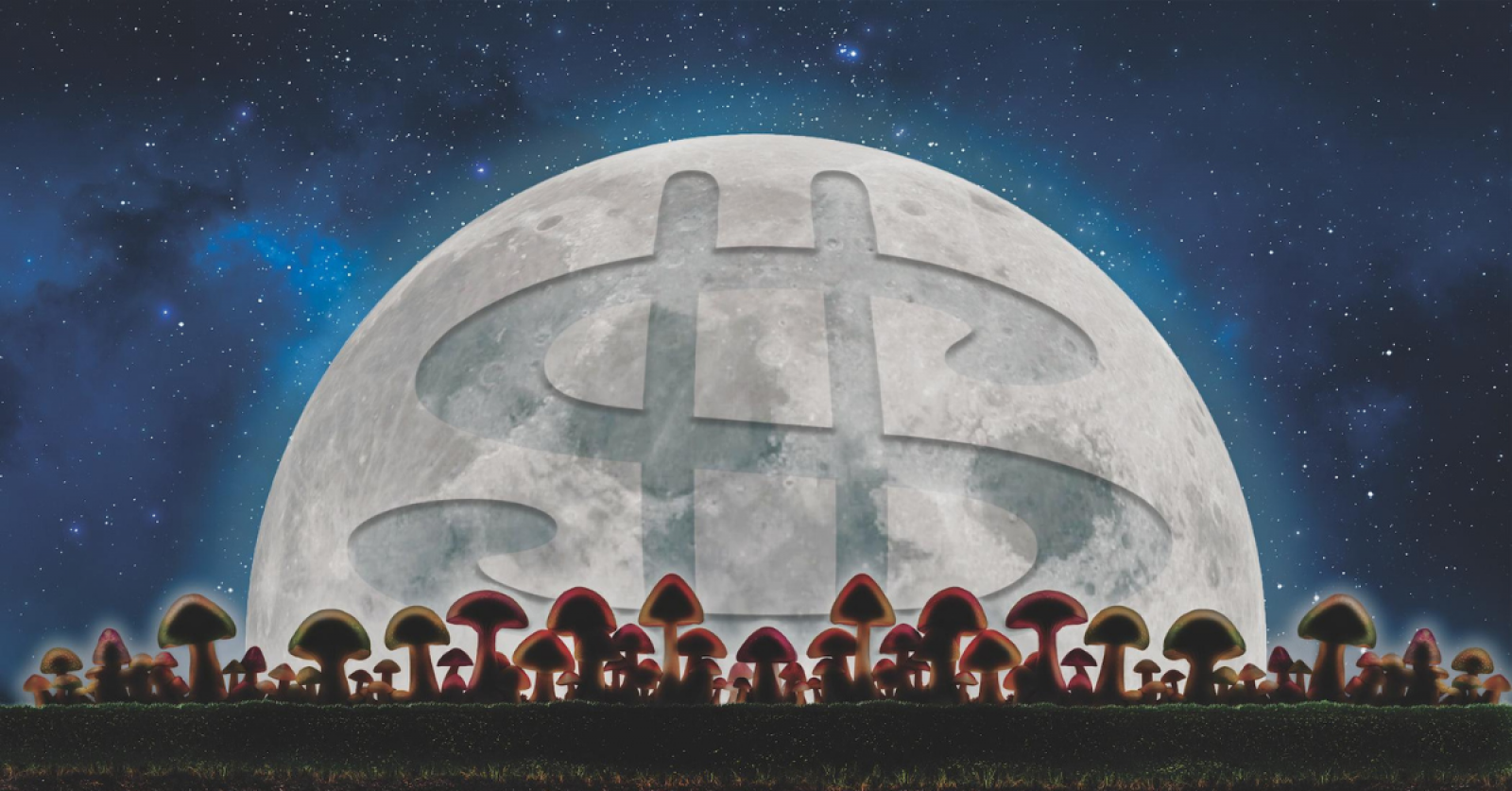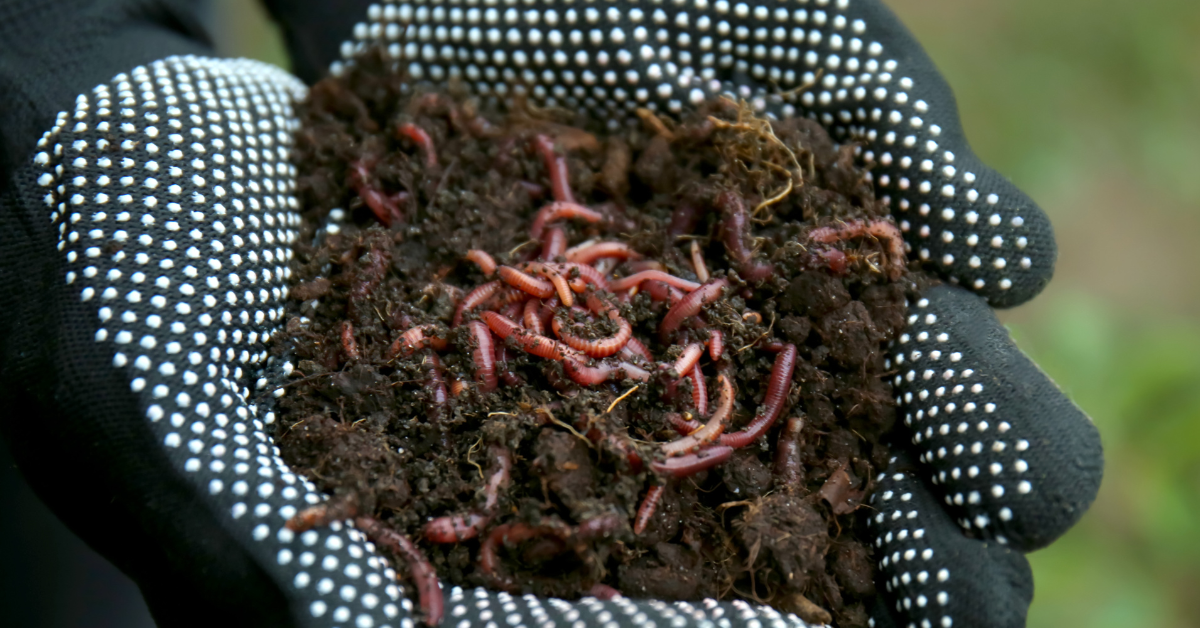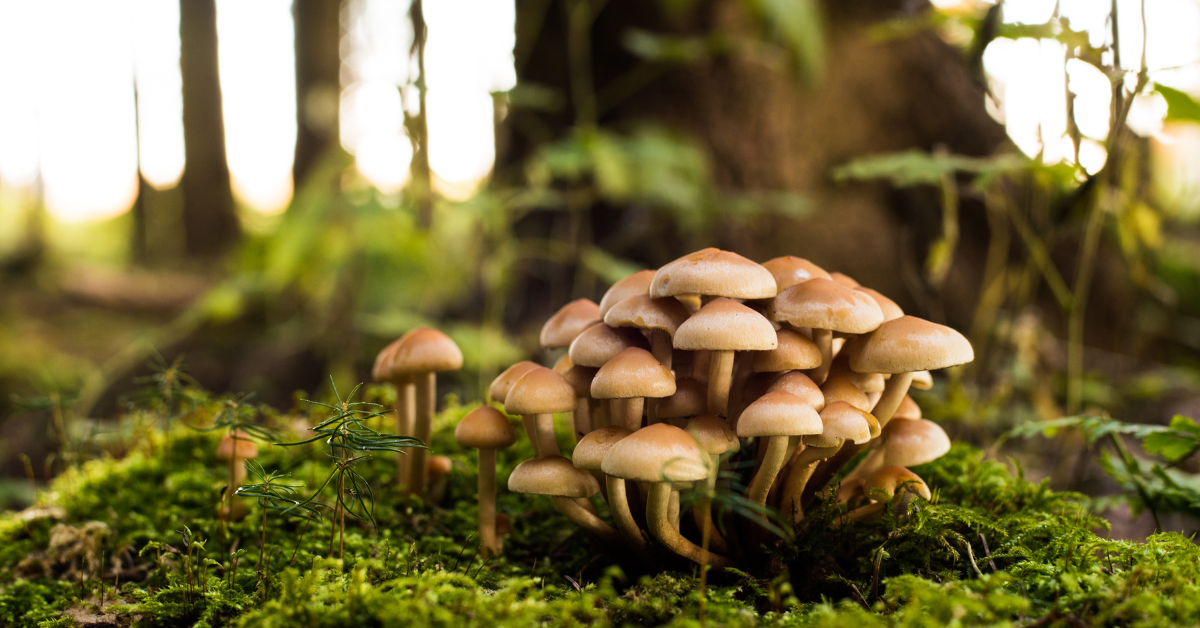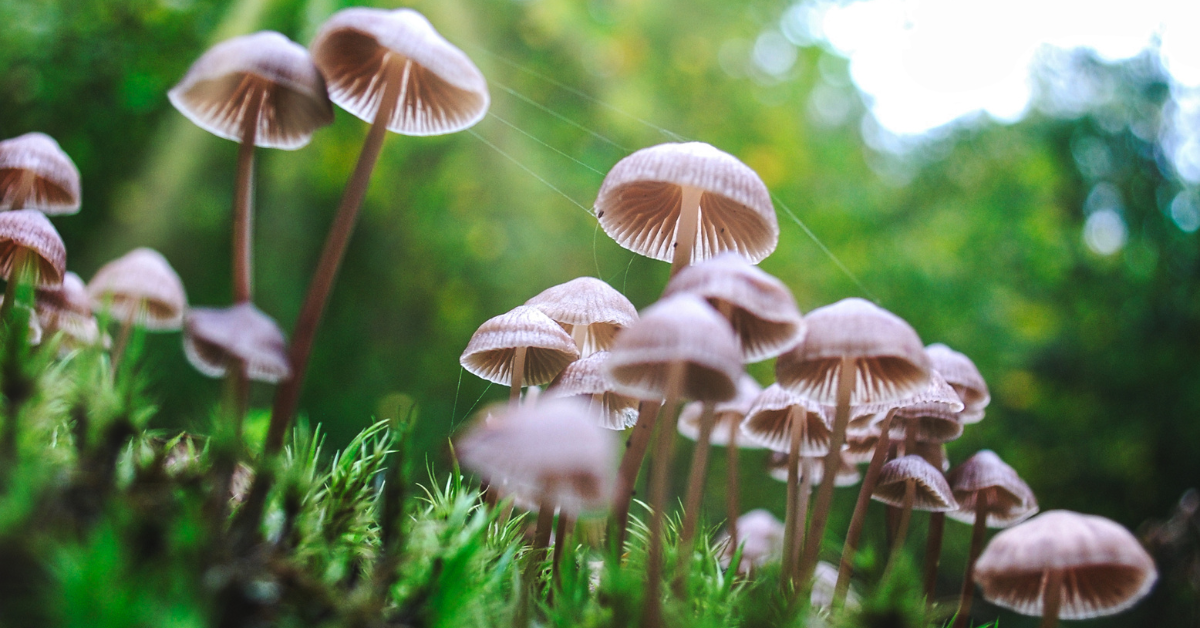March 14, 2024

Filthy rich: the dirt on growing media
BY JULIA HARMSWORTH
Growers across Canada are leveraging biology to grow strong, healthy plants without compromising sustainability. Creative technologies in growing media — from heroic worms to magic mushrooms, to marine creatures — are making soil filthy rich.
Jamie Aalbers, growers sector specialist at the Canadian Nursery Landscape Association, said growing media are very individualized. Each grower likes to use a particular soil mix, and while most source it from a company, some even mix it themselves. It all depends on the grower’s needs, location and what they’re planting. “Each grower has their own way of doing things,” Aalbers told Landscape Trades.
The biggest trend in growing media Aalbers has observed over the past five to 10 years is a reduction in peat usage. Greenhouse flower growers do predominately stick to peat moss, but nursery growers are reducing their use of peat in container growing, preferring bark, wood fibres and other composted materials. Innovative soil mixes that combine peat with wood fibres are increasingly common, as well as ones that use biochar.
“It’s an environmental concern,” Aalbers explained. “When you’re harvesting peat, you’re digging the wetland up, basically. Those wetlands store tons of carbon and when you dig it up and use it as a soil, that carbon is released. And [that’s] not to mention the environmental degradation of the wetland itself.”
Another concern is fertilizers leaching out of plant pots and into the environment. Aalbers said nursery growers are turning to slow release fertilizers, which are added at the beginning of the grow cycle and release slowly over time, as the plant needs the nutrients. He said most nursery growers use synthetic fertilizers.
Innovative individuals across Canada are contending with these concerns, using biology to formulate interesting solutions. One Ontario-based company, for example, is making creative soil mixes — without wood fibres.
Worms wear capes
Pure Life Soil digs into earthworm castings — in less elegant words, earthworm poop. The company is the only Canadian Food Inspection Agency (CFIA)-certified worm casting producer in Canada, selling three soil mixes made of the stuff. Their 100 per cent organic earthworm castings are otherwise known as “black gold.”
About 60 million earthworms currently live in the company’s 50,000 square foot facility in Toronto, Ont. Staff place them in cooled flats and feed them soil, and in return, the worms produce fertilizer (castings) with high nitrogen levels. The worms also produce microbes and beneficial nematodes: naturally occurring microscopic roundworms that promote healthy soil and trap carbon.
“[Beneficial nematodes] are what gets life going in gardens, in crop fields, in greenhouses. That’s what you need,” said Helen Stailos, Pure Life Soil sales director. “[We believe] earthworm castings are the healthiest and most nutrient-dense fertilizer you can use. It’s the best fertilizer known to humankind.”
Stailos said anything grown with worm castings will have a strong root structure, which, in turn, gives plants the best size, colour and fragrance. And, unlike cow or sheep manure, which contains hormones and greenhouse gases due to the animals’ diets, worm castings don’t contain any harmful chemicals.
“Earthworms have the ability to eat toxic metals and toxic anything, and when it passes through a worm’s body, it turns into a pure, filtered byproduct that is odourless. We call it clean dirt. I’ll touch it, and then eat my sandwich,” Stailos said.
In the spring, pickers will grab their headlamps and head up north to collect more worms and bring the facility’s stock to 250 million. The worms are picked at night under specific weather conditions; pickers must check the moon cycle and wind patterns beforehand. Pure Life uses Canadian nightcrawlers, European nightcrawlers and red wigglers — the latter two of which eat half their body weight each day.
“They’re voracious eaters. They’re superheroes of the planet. When we go to schools and teach children, we tell them, ‘They’re little superheroes. They should be wearing capes,’” Stailos said.
The worms’ other superpower is carbon capture. Their castings detoxify dead soil and support a healthy soil ecosystem, promoting vitality and helping the plant trap carbon through photosynthesis. For Stailos, this is a reason to choose organic growing media over synthetic substances: they wake up the soil. “The worm castings are the key,” she said. “There’s a symbiotic communication under the ground happening with fungal activity, and the roots talking to each other, and communicating with the air above. You get a healthy and harmonious exchange of carbon and oxygen. That’s when the magic starts to happen.”
Shaking hands with fungi
Ontario-based Root Rescue also leverages symbiotic relationships. The company’s Transplanter product harnesses the power of mycorrhizal fungi to put life back into soil. It’s made of 18 different fungal species, with no added chemicals or synthetic fertilizers, and is CFIA-certified. It can be applied while planting or injected into the roots of previously planted trees and shrubs.
This type of fungi — also called “mycorrhizae” — has a symbiotic relationship with plant life. Plants draw carbon dioxide from the atmosphere and convert it into sugar through photosynthesis. They keep much of this sugar to grow, but send 40 per cent deep into the soil to feed the fungi. In return, the fungi gives the plant water and nutrients. Bob Reeves, owner of Root Rescue, describes this exchange as a “handshake.”
“If you’ve ever wondered how a forest lives, it’s mycorrhizae,” Reeves said. “What mycorrhizae does is make miles of roots that find water nutrients. They bring it into the tree system, and they have an agreement with the tree. The tree, through photosynthesis, makes sugar, and it feeds them, and that’s what makes the spores.”
Root Rescue’s products restore the natural organisms that promote this process and create a healthy, filthy rich soil environment. The root only needs to be rescued once; when it’s treated, it keeps the nutrients forever and grows healthier. Root Rescue reintroduces something that’s missing — the fungi — and re-invigorates the plant’s natural carbon capture process. So, it isn’t just carbon neutral; it’s carbon positive.
“All those roots are carbon capture systems. When the frost hits new roots, they all die, capturing that carbon in the ground where it belongs. When the soil warms up, those spores make all new ones. And if the tree’s alive, those spores will make mycorrhizae. It’s pretty amazing stuff,” Reeves said.
Jamie Aalbers has seen exponential growth in the use of mycorrhizae in the past five to 10 years — especially in transplanting, to improve the success of trees that are moved from container to landscape. The fungi is also being added to soil mixes to improve soil health, with other new biological amendments. MustGrow in Saskatchewan, for example, gained U.S. Department of Agriculture (USDA) organic approval for a mustard plant-based soil amendment this past October.
Root Rescue also reduces the amount you need to water your plants, protecting the environment — and your wallet. Reeves said mycorrhizae can find 30 to 40 per cent more water from the soil than the root can by itself. Plants without a healthy soil ecosystem, by contrast, are at a “tremendous disadvantage” and are more likely to die during a drought.
Like Stailos, Reeves believes synthetic fertilizers are unsustainable. He said they damage the ecosystem and are inefficient. A farm may purchase 100 kilograms of synthetic fertilizer for a soybean field, for example, but only a “paltry” amount of that fertilizer actually ends up in the soybeans. The rest leaks into the ecosystem, damaging waterways.
Because synthetic fertilizers are salt based, they can also dehydrate the soil, reduce the plant’s ability to take in rainwater and kill the natural organisms in the soil that support the plant’s growth, Reeves claimed. Then, the plant gets addicted to the synthetic fertilizer, depending on it to replace what it’s killed. Organic growing media — like worm castings — do the opposite. They animate the plant.
“It’s the old paradigm: Do you want to give the hungry man the fish or do you want to show him how to fish? Once you give the plant back its fishing lures and technology, it can feed itself,” Reeves said.
Swimming in a circle
Acti-Sol, a natural fertilizer company based in Quebec, gives the hungry man — or the hungry plant — the fish. The company supports environmentally conscious gardening by recycling waste and promoting alternatives to chemical fertilizers. It sells a series of marine fertilizers — shrimp flour, granulated algae and hydrolyzed fish — as well as pure hen manure.
The hen manure came first, when the company decided to do something sustainable with the waste their eggproducing hens naturally made. The owner went to Europe and came back with a new technology: a huge dryer that uses the heat from the hen house to dry the manure. It’s then recycled into fertilizer, with added natural ingredients like bone meal. No other source of energy or machinery is used to dry the manure.
“It’s a good way for us to divert a product that would otherwise sit on land. Manure left to the elements will compost and can become a polluting bomb,” said Anny- Sandra Hamel, Acti-Sol representative. “It’s all part of the circular economy.”
The hydrolyzed fish solution uses a cold hydrolysis process to provide necessary nutrients and preserve amino acids. Hydrolysis is a chemical reaction in which water breaks down chemical bonds. When sprayed on a plant, the solution encourages healthy bacterial growth in its ecosystem, stimulates root growth and flowering, and increases the Brix — sugar — rate in fruits and vegetables.
The shrimp flour and seaweed products also stimulate microbial life in the soil, promote rooting, correct nutrient deficiencies, and restore soil fertility and water retention capacity. Hamel said the algae is picked sustainably; it’s cut at the top, not torn out at the root. Sustainability is important to her and, like Stailos and Reeves, she doesn’t believe synthetic fertilizers are a healthy medicine.
“When you’re sick and you go to the hospital and you’re plugged into an IV, you get an immediate boost. But really, what you should be doing is eating properly, you should be exercising and you should be sleeping right. So, it’s kind of the same. We need to feed the soil. That’s what organic fertilizer does,” she said.
NVK Nurseries also sees the sustainable merits of our aquatic friends. The wholesale nursery, based in Southern Ontario and serving clients across Canada and the Northeastern U.S., keeps four 500-gallon tanks of koi fish on their property. The water feeds into growing beds of aquatic plants, which are fed by the fish’s waste.
“The nitrates get taken out by the plants, and then the plants clean the water and then it’s filtered right back to the fish tanks again,” said Derek Vanderkruk, NVK perennial manager and part-owner. “So, it’s all a self-contained, bound system where we don’t have to add any fertilizers. [The elements] all work together to keep each other’s environments growing well.”
The fish-fertilizer system has increased the plants’ lifespan and allowed for propagation. Before the koi fish moved in, the tanks were home to over 500 tilapias. The fish grew from two inches to two pounds before they became inactive, and the nursery’s staff took them home for dinner. Tilapia grow faster (and perhaps taste better) than koi, but don’t thrive in cold winter temperatures.
This circular, no-waste system is a blueprint for NVK; the Vanderkruk family tries to run the business as sustainably as possible, so it lives for generations to come. They limit their use of artificial fertilizers, focus on what each individual plant needs, use regenerative cover crops, have their own composting facility and work to rejuvenate their soil.
Jamie Aalbers said the nursery industry is contending with their impact on the environment. Like NVK, nurseries across Canada are talking about best practices and making improvements to field production. He noted that nurseries and growers also understand the inherent environmental benefit of the plants they grow. Each tree, shrub and flower wears a cape, and new technologies in growing media only aid their mission.
“We're always trying to look towards the next generation. We're just being caretakers. That's our calling in life, too," Vanderkruk said.


